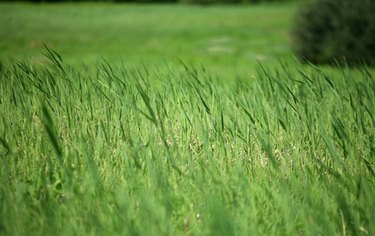Things You'll Need
Lawnmower with sharp blades
Water
Spiked shoes, a screwdriver or a lawn aerator
Compost

There's nothing quite like the feeling of walking across a lush lawn of thick, green grass. When the grass is green and thick, it's an enjoyable place to spend time with friends and family. Thick, green grass is also much healthier and easier to take care of because weeds are unable to take hold in healthy grass, and the lawn needs less water, mowing or other care. Getting your grass to become greener and thicker may take some time and effort, but once you have it at that healthy state, the investment will have been worth it.
Step 1
Adjust your lawnmower blade so that it's cutting the grass at longer heights. By cutting the grass down really low, you're making it difficult for the grass to get enough sunlight to become healthy. A healthy cutting height is three to four inches. At this length, grass is able to send down stronger, deeper roots and collect enough sunlight to become lush and green.
Video of the Day
Step 2
Make sure your lawnmower blade is sharp before each cutting and sharpen it every two to three times you use it to ensure you're cutting the grass cleanly and not tearing it. Dull lawnmower blades will tear the grass, causing it to spend time and energy repairing itself instead of growing thick and green.
Step 3
Water deeply--at least one inch of water each time--and infrequently. By watering deeply but infrequently, the top section of the soil will dry out and the grass roots will dig down deeper into the soil to reach the water that is located there. If you water frequently, the roots won't bother to dig down deep because there will always be water available near the surface. When grass is watered too frequently, it will create clumps and runners that block the soil from being able to access sunlight and water; this weakens the grass and prevents it from being able to become as thick and green as you'd like.
Step 4
Leave grass clippings lying on the lawn after each mowing. The grass clippings break down and compost, adding nutrients to the soil that help the growing grass become healthier.
Step 5
Poke holes into your lawn occasionally using spiked shoes, a screwdriver or a lawn aerator. These holes allow more moisture and air to get down into the soil and loosen it up so the grass roots are more easily able to dig down to healthy depths.
Step 6
Add compost to the lawn each fall to help build up the soil quality and add nutrients the grass will be able to use the next season.
Tip
Wash your lawn occasionally by adding a capful of dishwashing liquid to a gallon of water. Washing it like this adds nitrogen to the lawn and removes dust and debris so the grass blades are better able to utilize the sunlight they're receiving.
Video of the Day